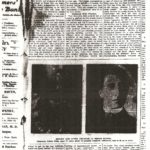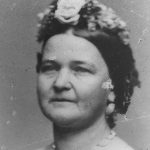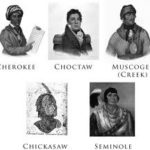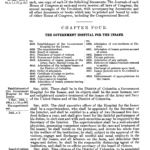Fry bread (or frybread) is associated with Native American cuisine, but it is not a traditional food for native peoples. The food originated during hard times, and is a symbol of both pride and pain.
In 1863 Gen. James Henry Carleton, commander of New Mexico Territory, rounded up Navajos and Mescalero Apaches in the Four Corners region and forcibly marched them from Ft. Defiance in Arizona to a camp called Bosque Redondo at Fort Sumner. Around 10,000 men, women, and children (including the elderly) walked 450 miles into this eastern New Mexico encampment. Many died along the way or were shot as stragglers. This tragic event is known as The Long Walk.
Once in Bosque Redondo–which was 40 square miles of shortgrass prairie and desert that wouldn’t support farming–at least 2,380 people died of exposure, disease, and hunger. The U.S. government finally issued commodity rations like white flour, lard, sugar, and canned goods to alleviate the misery. Fry bread was a filling meal these prisoners could make, though it was not a nutritious one.
Today fry bread is still a common food which is also popular and prominent at celebrations and powwows. The bread has been eaten for many years by Native Americans and represents a shared culinary experience among many tribes, but more importantly, it represents their perseverance and resiliency. Fry bread is a subsistence food that represents repression and hard times on one hand, yet speaks to triumph and tenacity on the other.
In 2005, the Bosque Redondo Memorial center opened as a place to mourn the dead and to celebrate survival.









Seven Drum Alter Fern 7/1/2016
In Our homeland the elder’s were altered mentors
Inside my mind was occupied with primitive spiritual questions
The provisions were Red Skies and Red Cedar
Going out on a limb and Juniper berries
The elder knew the place a million sweat rounds ago
The superstition was how I got to the sweat grounds with the whole lot
The material was sneaked into a fenced in sweat grounds ALL federal (Illegal)
Not Federal as in: Government plates on a B.I.A. pick up truck
Sweet Grass remind me a lush fern growing between the holly tree and the ditch
The Red Cedar limb and pale Juniper berries were a full plate
Red Sky wanted to transplant the fern with me; yet she wasn’t allowed to date
Yes the ferns can be transplanted during Independence Day if careful
Enquiring the elder after I federally left the Red Cedar limb and Juniper berries
Red Cedar limb and Juniper berries sat for 24-hours atop the original alter
Then the Klamath/Modoc hastily aroused my despise
Setting up camp, working for my breakfast, Klamath/Modoc played medicine man in smoke
Work won’t get done without workers then he ties off Eagle feathers
Ties off Eagle feather after Ego feather on the small sickly limbs on original alter
No need of altering-the original sweat lodge alter
Washat (religion) rained down sending for the boy at the worn grandfather (rock) piles
Reminiscing of the whitetail deer hunts at Cayuse proper wheat grounds
Elder stood at the alter and longstanding traditions of the Southwest Klamath/Modoc
The family drum (arrived) AHA!!! (build an alter and drum grounds)
The cool reservation kids sit in the corner at the spillways towards the wetlands
Elder blesses the grounds showing the way to let His kids play with toys, live and live in peace
Red Cedar limb went big end in ground; the most beautiful alter limb in the whole world
The string I found from the bundled hand towels was used to tie off the Juniper berries
Then I asked all the cool Rezervation kids to clip I.D. tags to the strings
We are the cool reservation kid’s broken on the family tree on sweat grounds
The cool reservation kids own an alter for the drum and 4 seats of Doug Fur wood rounds
Dreams up and down, a family drum for Red Sky her 2-children and her man a she calls a Poet
Chippewa earned 2-feathers learnin’ Indin’s drummin’ lessons says elder on way to The Grounds
The cool reservation kids swarm and gather aroun’ the worn old hot grandfathers (rocks)
The worn out grandfathers split up to spread sacred knowledge, but who wants to listen and learn
On the inside of the lodge Klamath/Modoc played medicine man smoked out the crawlers
Red Eyes like a flock of geese; AKA love in disguise. Red Sky never denied me her cup of water
Grandfather if the alter is important so is Red Sky, her geese, and transplanting a fern to the alter
Song: Seven Spanish Angels. Ray Charles Willy Nelson
Religion:
The Seven Drums Religion, considered a direct descendant of the Prophet Dance, has long been a focal point in the revitalization of Nez Percé traditional religious practices. The religion is a blend of vision quests seeking personal spirit powers and some Christian elements in a native communal worship framework. It is also known as the Long-house Religion, as it was performed in traditional longhouses throughout the Columbia Plateau region and led by highly charismatic individuals. The first roots feasts in spring, a first salmon feast slightly later, and a berry feast toward summer’s end as well as funerals and memorials are commonly celebrated in the Washat format. Read more: http://www.everyculture.com/multi/Le-Pa/Nez-Perc.html#ixzz4DCokCFgI
Hi Todd,
I understand that water is the next big “thing” to worry about all across the globe. I’m definitely trying to do my bit to treat the land gently and be organic in the way I grow things…if enough people will follow suit, we can solve some of these problems.
Best regards,
Carla
Hello Carla I look on RFD-TV a lot and they are predicting a lot of droughts. I looked on Indian.com to see about rain dance and got this turquoise information they used in rain dances down in your southwest area not in Umatilla Reservation where I’m from. I wrote this poem for my great friend Lawanda Bronson a professional horse racer and her barrel horse Corona Cartel…
Slowly Flood You 4/5/2016
Shadow Girl’s Umatilla Basin plateau frontier
Was still dusty from an inch of February cotton
Pretty Indian girls always carried cotton
In case a cold snap hurt their ears of corn
Cold corn wasn’t on a stalk it was stored in a grain box
Half a coffee can for the barrel horse Corona Cartel’s winter coat
Now turned to mange from a predicted decade of climate change
Shadow Girl pulled onto the mighty freeway to visit all the damns
Traffic jams she was all Professional Rodeo Woman WPRA
She felt she ate 10-Saltines as she blew her rodeo outfit around Hoover Dam
Corona Cartel maneuvered her to the elite spot for a gigantic sponsorship
Her sponsor was a rainy dancer turquoise bling jeweler for the western regions
He spotted Shadow Girl’s outfit like a dope spade bit on a Diablo Vaquero
Corona Cartel answered all of Shadow Girl’s turquoise barrel prayers
Corona Cartel was of the school if you have no more clean drinking water
All of mankind’s nightmares will begin to slowly flood you
Trying to write contemporary poetry on real western region themed events especially climate change on the west I believe the ranchers need to learn meditation in case they want to go off about their problems like they do in Australia currently.